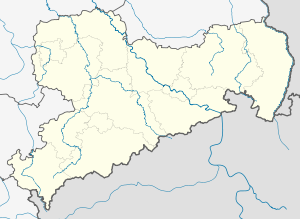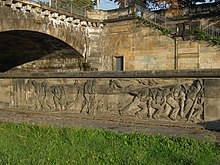Albert Bridge
Coordinates: 51 ° 3 ′ 26 ″ N , 13 ° 45 ′ 16 ″ E
| Albert Bridge | ||
|---|---|---|
| Albert Bridge as seen from the Frauenkirche | ||
| use | Road bridge | |
| Subjugated | Elbe | |
| place | Dresden | |
| construction | Arch bridge | |
| overall length | 316 m | |
| width | 22.20 m | |
| Clear width | 31 m | |
| vehicles per day | approx. 13,800 vehicles , approx. 9,000 cyclists, tram (lines 6 and 13 with approx. 23,000 passengers per day) | |
| start of building | June 14, 1875 | |
| opening | November 19, 1877 | |
| location | ||
|
|
||
The Albertbrücke is the easternmost of the four Elbe bridges in Dresden city center. The 316 meter long bridge is named after King Albert of Saxony . In GDR times it was called the Bridge of Unity , commemorating the unification of the KPD and SPD (1946) .
Location and structure
The bridge connects Sachsenplatz in the south with Rosa-Luxemburg-Platz in the north. From there, Glacisstrasse and Hoyerswerdaer Strasse lead into the Äußere Neustadt . The bridge is part of the 26er Ring , which continues south with Sachsenallee and Güntzstraße. At Sachsenplatz there is also a connection to the Terrassenufer and the Käthe-Kollwitz-Ufer . The drive over the bridge streetcars of lines 6 and 13 . Before the renovation (2014–2016) the bridge was used by 19,400 vehicles a day with a heavy load share of 2%. With 9,000 cyclists a day, the bridge is the most important Elbe bridge in Dresden for bicycle traffic.
The bridge structure consists of 14 stone arches that are symmetrical to the 7.5 meter wide central pillar. The four stream openings have a clear width of 31 meters. The smallest passage height is about 7.90 meters at the highest navigable water level. After the renovation, which was completed in September 2016, the bridge is 22.20 meters wide. The bank pillars were founded in an open excavation; for the river pillars by means of a caisson . The distinctive central pillar is adorned on the upstream side with a relief portrait of King Albert of Saxony and on the downstream side the Dresden city coat of arms, both made of Carrara marble .
history
The construction of the bridge according to plans and under the direction of Stadtbau-Oberingenieur Karl Manck began on June 14th, 1875. On November 19th, 1877 the inauguration as König-Albert-Brücke followed . On May 7, 1945, three arches were blown up on each side of the bridge. The reconstruction with clad reinforced concrete arches was completed in July 1946.
Status

Due to decay processes, the safety of the bridge was no longer guaranteed in the second half of the 2000s. In particular, the railings were no longer anchored firmly enough. Pieces of sandstone threatened to break off. For this reason, measures were taken to ensure usability and safety until the thorough renovation : the speed was reduced to 30 km / h, the outer half of the footpath and bike path were blocked and secured with a construction site barrier. In order to provide a suitable width of the footpath and bike path for pedestrians and cyclists, this was moved to the detriment of the roadways until a temporary bridge was opened. At times, only one lane divided by motor vehicles and trams could be used in each direction. This resulted in significant backlogs and delays in tram traffic, especially in rush hour traffic .
In October 2013, protective roofs were installed for 70,000 euros to protect the cycle paths leading under the bridge from falling stones.
Temporary bridge
In autumn 2011, a temporary bridge was built on the city side of the Albert Bridge. As a result, the staggered sidewalks could be removed again, and the bridge had its original capacity for vehicle and tram traffic again at the end of November. The makeshift bridge was colloquially known as the "Little Albert Bridge". Due to the occasional slipperiness of the wooden planking, cyclists fell.
On September 8, 2015, the temporary bridge was closed after approval of the completed half of the new Albertbrücke and demolished by the end of 2015.
Redevelopment
Originally, the renovation and the associated widening of the bridge was supposed to begin in 2008, after safety measures had been taken since 2007. The project was delayed due to an objection by the State Monuments Office against the widening. The renovation was not started because the completion of the Waldschlößchenbrücke , which was to serve as a diversion for a large part of the traffic during the construction period, was delayed until August 2013. As part of the renovation, the bridge was widened by 3.60 to 22.20 m. On both sides, 1.60 m wide bike paths and 2 m wide footpaths were planned. The originally planned widening by 4.70 m was discarded for monument protection reasons.
In May 2010 the city council decided to renovate the bridge. Initially, a quick conversion was planned, in which the bridge would have been closed to car traffic for eight months and several times (a maximum of two weeks each time) to tram traffic. In mid-June 2013, the city council voted in favor of this rapid reconstruction of the bridge. The quick version could have been implemented from September 2013. The construction time was given as 21 months. Mayor Helma Orosz , however, vetoed it for reasons of cost. According to the city, the state has indicated that the subsidies assumed in the city budget would not be provided in this amount. The state's share in the financing of the project was 75 percent.
The so-called variant IV with maintenance of car traffic would have been around 3.3 million euros more expensive than the high-speed variant at 28.7 million euros. If the city council had decided to implement this variant, construction could have started between March 2014 and the beginning of 2015. If a supplementary planning approval procedure would have been necessary, the start of construction would not have been foreseeable. Saxony's Transport Minister Sven Morlok (FDP) promised four million euros in additional funding for this variant. With this variant, tram traffic would have been interrupted for 8 weeks; the Dresden public transport company expected additional costs of 1.6 million euros for this alone.
According to the mayor of the administration, Lehmann, the postponed start of construction means that the legal basis for the continued operation of the bridge no longer applies. Immediate measures should therefore be taken or the bridge should be closed. In order to minimize damage, a speed limit for trams of 10 km / h was set and the outer lane lanes in the area of the shipping arches were closed. The latter was done in order to reduce the risk to shipping traffic from falling stones.
On September 26, 2013, the city council voted for the originally planned renovation. The CDU, who originally voted against the project, justified its change of opinion with the deteriorating condition of the bridge. In the meantime, roofs had to be built over the underpassing cycle paths and a disaster concept had to be developed for ship traffic. The FDP was the only parliamentary group to vote against the renovation, since the condition of the bridge has not changed and drivers should not be made difficult. The renovation began at the end of May 2014. The bridge was closed to all car traffic and the tram ran on a single track on a temporary track. The work was estimated to take around two years and cost a total of 21 million euros.
On August 24, 2015, the first half of the Albertbrücke was cleared for trams, and on September 8, 2015 for cyclists and pedestrians. The Albertbrücke was released for motor vehicle traffic and for trams in both directions on September 5, 2016, and Rosa-Luxemburg-Platz and Sachsenplatz are fully usable again.
Artwork near the bridge
At the foot of the bridge on the banks of the Neustadt Elbe are two sandstone reliefs that can be seen from the Elbe. With this direction of view, the left relief shows the historical river life. It was created in 1936/1937 by Herrmann Alfred Raddatz . It is 1.4 meters high and 12 meters wide. It depicts men who are believed to be carrying out ship loading work, as well as a ferryman with his boat. The other relief to the right of the bridge was created by Edmund Moeller in 1938 . Men are shown pulling ships . The relief is 1.4 meters high and 10 meters long.
There is a memorial to Rosa Luxemburg at the Neustädter bridgehead . The Rosa-Luxemburg-Platz , to which the Albertbrücke leads, is named after her .
literature
- Erich Fiedler: Bridges of City Expansion. Albertbrücke - Carolabrücke - Flügelwegbrücke. In: Dresdner Geschichtsverein e. V. (Ed.): Dresdner Elbbrücken in eight centuries , Dresdner Hefte No. 94, Dresden 2008, pp. 51–60.
- State Office for Monument Preservation (ed.): The old Albert Bridge in Dresden . Sandsteinverlag, 2016 (144 p., 135 partly colored illustrations).
Web links
Individual evidence
- ↑ Dresden themed city map, “Traffic volumes in vehicles / day” , accessed on November 16, 2017
- ↑ Press release , accessed on August 18, 2016
- ^ ADFC website , accessed January 8, 2011.
- ↑ Erich Fiedler: Bridges of the city expansion. Albertbrücke - Carolabrücke - Flügelwegbrücke. In: Dresdner Hefte, No. 94, Dresden 2008, pp. 51–60.
- ↑ The city secures cycle paths under the Albert Bridge . In: Saxon newspaper . October 5, 2013, ZDB -ID 2448502-0 , p. 17 .
- ↑ Despite the risk of falling: Dresden Roads Office rates the temporary bridge over the Elbe as faultless ( memento from July 29, 2012 in the web archive archive.today ). Dresden Latest News (online edition), November 30, 2011.
- ↑ The last remains of the makeshift bridge are said to have disappeared this year. But breaking off is not easy . Sächsische Zeitung (online edition), October 29, 2015.
- ↑ a b c d e Tobias Winzer: At the Albertbrücke there is a threat of a long standstill . In: Saxon newspaper . July 12, 2013, p. 7 .
- ↑ Tobias Winzer: City council stops renovation of Albertbrücke . In: Schächsische Zeitung . July 12, 2013, p. 1 (similar version online ).
- ↑ a b c Statement from Mayor Jörn Marx on the Albert Bridge. In: dresden.de. State capital Dresden, September 13, 2013, accessed on August 15, 2015 (press release).
- ↑ Left inquiry: Dresden Albertbrücke after a city council resolution, apparently without an operating permit ( memento from July 23, 2013 in the web archive archive.today ). Dresden Latest News, July 23, 2013.
- ↑ Dresdner Albertbrücke more and more dilapidated - outer lanes closed from Thursday ( Memento from September 11, 2013 in the web archive archive.today ). Dresden Latest News, September 11, 2013.
- ↑ Christoph Springer: CDU overturns in the city council . In: Dresdner Latest News . September 27, 2013, p. 13 .
- ^ Peter Hilbert: Albertbrücke closed for ten months . In: Saxon newspaper . March 26, 2014 ( online ).
- ↑ Traffic on Albertbrücke again . (Sächsische Zeitung), September 8, 2015.
- ↑ Final spurt in the renovation of the Albert Bridge. In: dresden.de. State capital Dresden, August 2, 2016, accessed on January 17, 2018 (press release).
- ^ Art in public space . Dresden Cultural Office, Dresden 1996.
| upstream | Bridges over the Elbe | downstream |
| Waldschlößchenbrücke | Albert Bridge |
Carolabrücke (Dresden) |







